

Its all go in the orchards and after waiting so long to get started, the fruit maturity is accelerating and growers are stepping up the pace to get fruit off the trees and into storage.
On Wednesday the English Apple Man visited Paul Mansfield's Nickle Farm at Chartham in East Kent to follow the progress of Cox picking for 'long term storage'
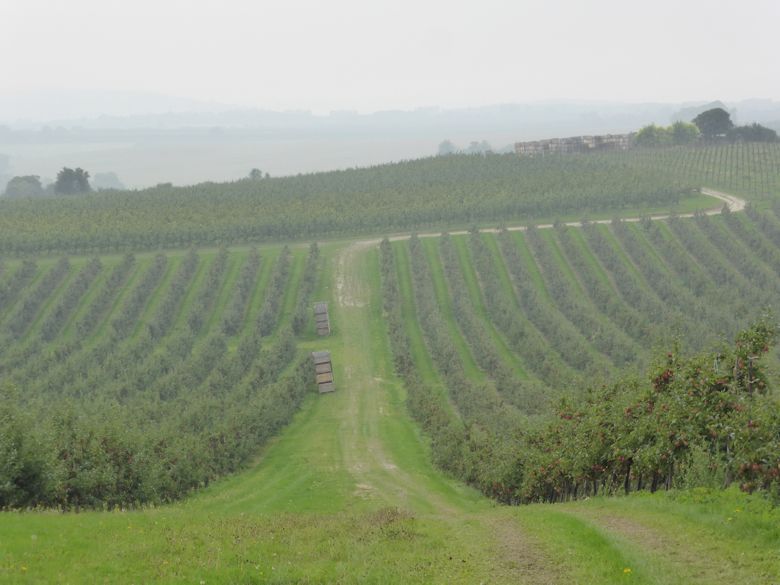
Cox picking for long term storage is well under way and fruit quality is very good with excellent red colour.
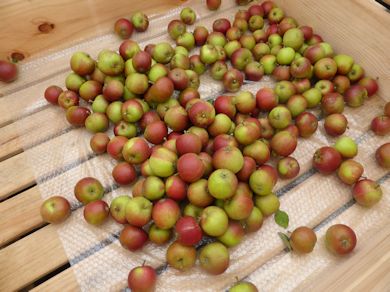
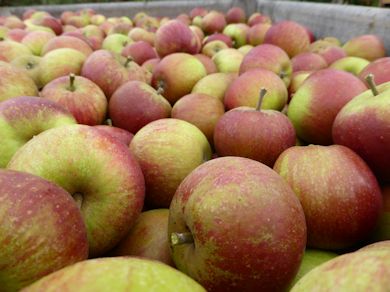
The use of picking trains is becoming 'the norm' but not all growers like it as it stops individual piece work picking, and is thought to reduce motivation. However with all pickers under the watchful eye of a supervisor, managing picking quality is 8 times better than one supervisor managing 8 pickers 'strung out' across the orchard.
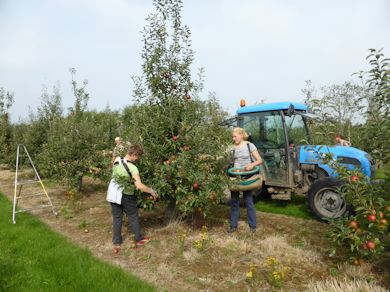
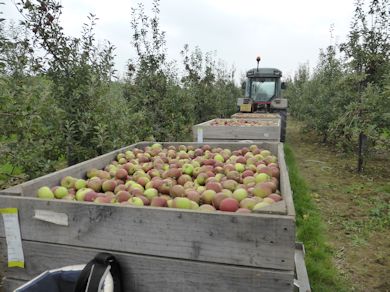
Picking in groups of 8 and using picking trains, the pickers quickly fill each bin. Averaging 4 bins each across the day, a bin is filled in 15 minutes and the train within an hour. The bins are then transported to the storage site and can be in the cold store within 2 hrs. This is the ideal scenario as the field heat (fruit temperature) is withdrawn quickly; rapid cooling is a very important element in successful long term storage.
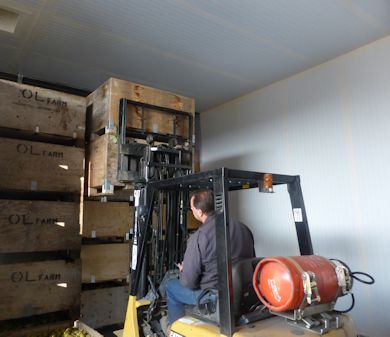
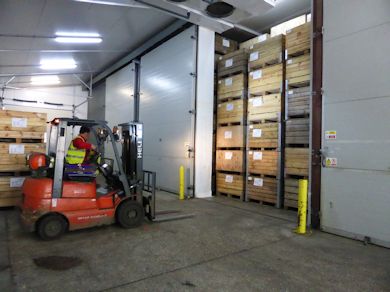
PIP to PLATE at Hadlow College
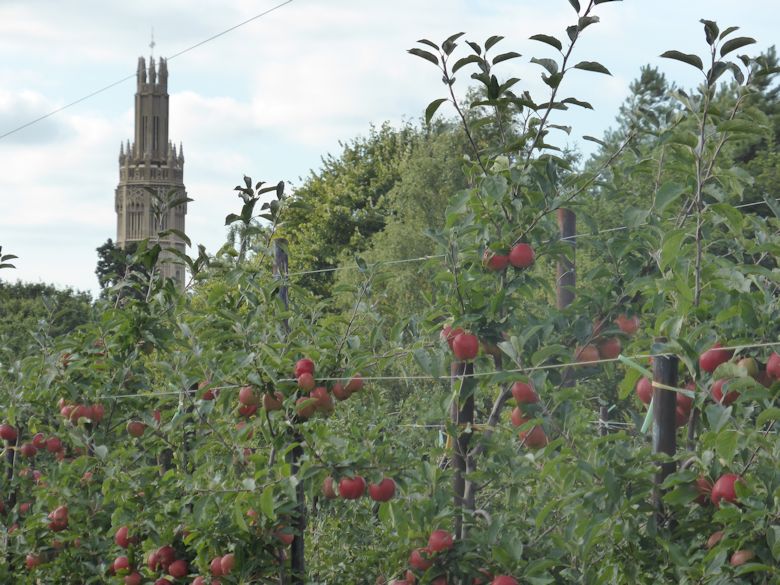
Last Friday (20th September) The English Apple Man took part in an event at Hadlow College in Kent designed to give secondary school children in that locality an opportunity to learn about how apples are grown.
The objective behind the PIP to PLATE event was to 'sow the seeds' of interest in the young people who might go onto seek a career in the fruit industry when they leave school and seek further education via the many opportunities offered by the Hadlow College Horticultural Prospectus.
The product of an idea discussed between Hadlow lecturer Stefan Jordan and a small group which included the English Apple Man a year ago, and driven by Stefan's enthusiasm, Pip to Plate finally came to fruition.
The location was 'a bit of a gamble' as we decided to use the BIFGA and HUXLEY trial orchards to demonstrate 'how, why and what' is behind the modern domestic apple. To say we were blessed was an understatement; the day started dry and warm and became steadily sunnier as the day progressed.
Pip to Plate picked out a few of the essential steps as an apple moves from a pip via budding and grafting, the challenges of crop protection, tree management, the science of modern apple storage and marketing requirements.
Practical arrangements
To ensure a smooth operation four groups arrived at manageable intervals. The first 20 arriving for a 10am start; splitting into groups of 10 before entering the Pip to Plate circuit.
Origin of the Apple:
The English Apple Man was first on duty, explaining the origin of the sweet apple we know today. Believed to have emerged in the Tian Shan in Western China (where apples of the quality we buy in our Supermarkets can still be found growing wild in the fruit forests) and improved by the first Breeders; e.g. Bears who with their sweet tooth, hunted out the sweetest fruit in the fruit forests and after 'the natural course' the pips found their way into the soil and the cycle of improvement continued. Malus pumilla is the sweet apple and the ancestor of today's domestic apple. Malus sylvestris - the European Crab apple is a quite different apple with ts dry taste and typically small fruit.
The Science of Breeding
Feli Fernandez, geneticist and breeder at East Malling Research explained how the apple is bred to improve fruit quality and in particular, resistance to pest & disease. Feli told the young visitors how each apple pip produces a unique new variety, some of which may be an improvement, but most of which will be inferior. It starts with a 'crossing programme' where pollen from a donor tree (identified as the male parent) is applied to the stigma of another tree (designated as the female parent) once germinated, the seedlings go through several rounds of selection to eliminate those with poor characteristics.
By the time the seedlings are budded onto rootstocks 18 months have passed.
Each year thousands of seeds (pips) are planted in the search for an improved variety. Out of thousands of young seedlings, only one or two may be considered worthy of planting on in longer term trial plots.
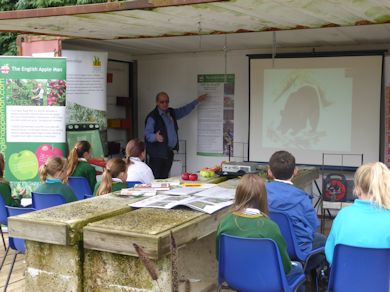
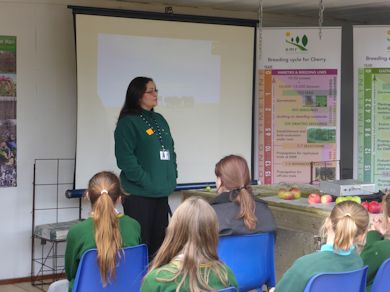
In the Nursery
The Seabrook family have farmed in the Chelmsford area since 1743 and the current William Seabrook is the fifth generation Nurseryman in the family Nursery business founded in 1886 by 'another' William Seabrook who was looking for a more profitable farming business, as the Agricultural depression of the late 19th Century hit farmers very hard. William showed the young people how to graft a variety onto a rootstock.
Planting It may be the wrong time of the year, but planting follows the Nursery and Hadlow College students, who supported the professional presenters throughout the day, showed the visiting school pupils how a tree should be planted.
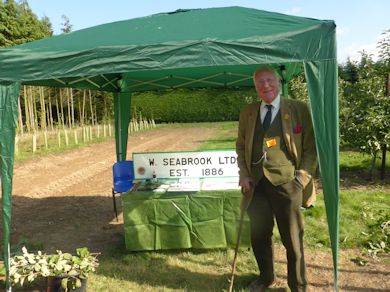
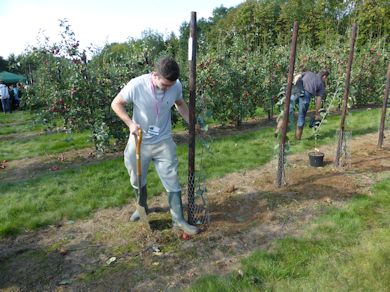
Crop Protection
Mike Hutchinson - CEO Hutchinsons - explained the mysteries of crop protection and the science used to protect our apples from various pests & diseases. Mike said, if we don't protect the crop then prices would rise and we would need more land to grow enough food to feed us all.To research, develop and register a new protective product before it is approved for use takes 9 years and costs more than £150 million. More than 200 scientific studies on the impact on human health and the environment are required before a product is approved for use.
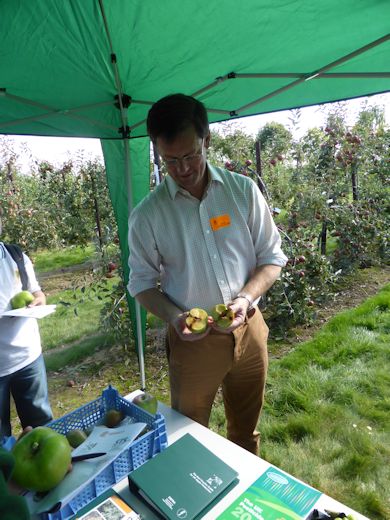
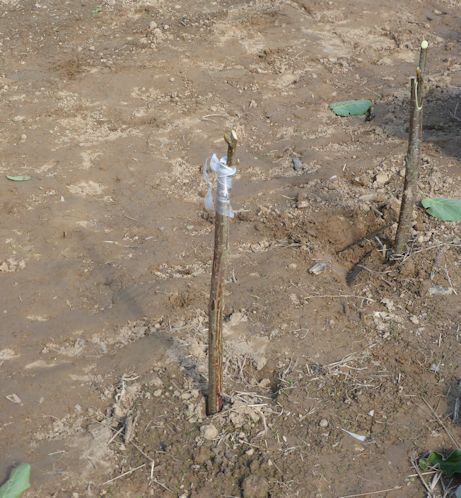
Tree training
FAST agronomists - John Clark and Philippe Parageaurd educated the pupils on how maximising the profit from a new orchard and attention to detail from the very beginning is paramount in the success of a new orchard venture. With a new orchard costing in excess of £25,000 per hectare to establish; e.g. trees, support system, irrigation etc. - no corners can be cut!
Ensuring the soil is in good condition is critical, and establishing nutrient status is determined by soil analysis, an important stage before any trees are ordered. The quality of the trees is also critical; plant a poor tree and it will NEVER catch up. Using the best quality 'feathered' knip trees is the next step on the ladder to success.
Tree training and management are vital if the trees are to deliver optimum yields. If all 'boxes are ticked' yields of 15 - 20 tonnes per hectare in the 2nd year in the ground (2nd Leaf) are possible and indeed 'necessary if the new orchard is going to justify its investment costs.
Apple Storage
ICA and STS personnel Simon Fitch and David Clough, explained the mysteries of apple storage, They told the assembled pupils that the reason for storage is to balance the supply across the marketing season, ensuring consumers received the best possible eating quality and providing the grower with an adequate financial return.
The storage season can be split into short term, medium and long term storage. To achieve 'long term storage' (up to April/May) requires an efficient cooling system, coupled with Controlled Atmosphere (CA) to maximise the longevity of the fruit in store. Simon and David showed the pupils how the atmosphere in the store is managed and the refrigerant systems used for efficient cooling.
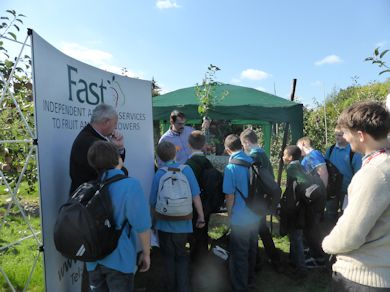
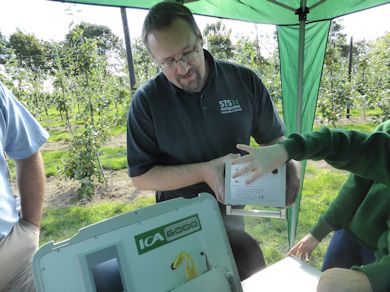
Business and Shelf life.
Chingford Fruit personnel, Simon Cannel - 'Trade Marketing Business Unit Director' and Lorna Clarke - 'Technical Manager Top Fruit', explained the marketing aspects of the supply chain and the quality criteria used to ensure consumer satisfaction. Simon said Marketing is ultimately understanding what the shoppers want and then delivering that product in a simple, exciting and interesting way. Lorna Clarke showed the visitors how fruit quality is measured for firmness with a penetrometer and Claire Donovan - Worldwide Fruit Account Manager - demonstrated the way we measure sugar (brix) levels.
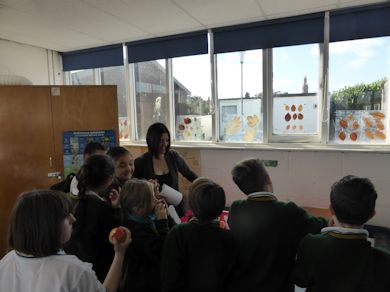
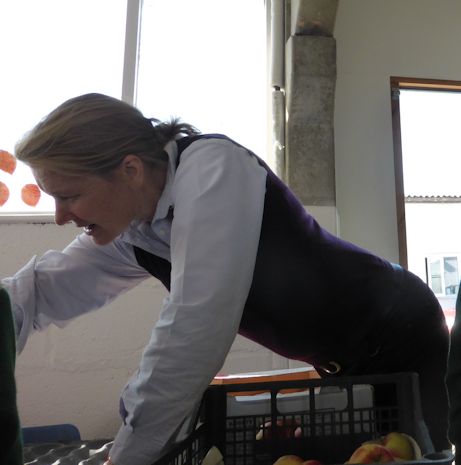
Following the four groups of school pupils 90 minute tours, BIFGA members were invited to join the event at 3pm and see for themselves a plethora of new varieties at the near harvest stage of maturity. The later than usual season allowed growers the perfect opportunity to see a high percentage of the varieties and the cooler nights and warm days have resulted in 'stunning' red colour.
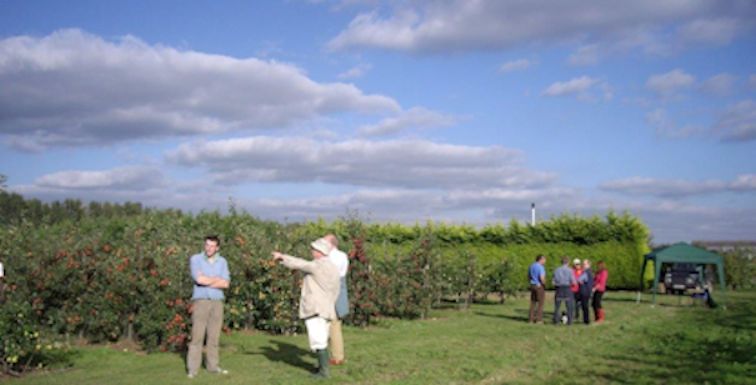
Crimson Crisp is a new variety and has resistance to scab. Stores to March if required (in CA) and is likely to be sold under the 'Red Dessert' banner.
Jugala is a week earlier than other Gala clones.
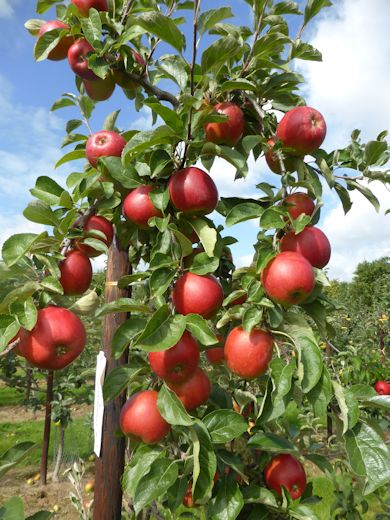
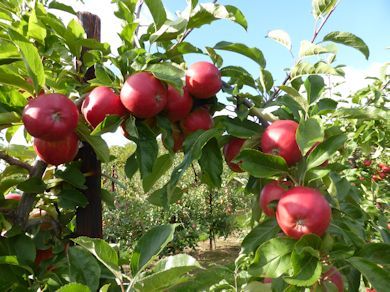
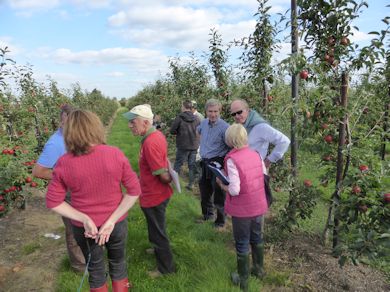
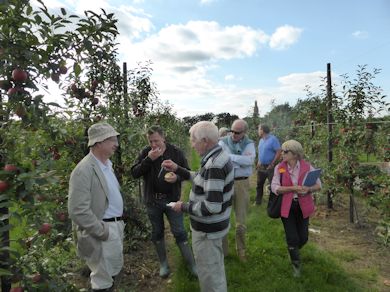
Santana a modern, Dutch variety with reduced allergenic properties, bred especially for those who are normally allergic to apples! An excellent disease resistant modern variety.
Gala Schniga is a highly coloured Gala clone and reported to store very well.
.jpg)
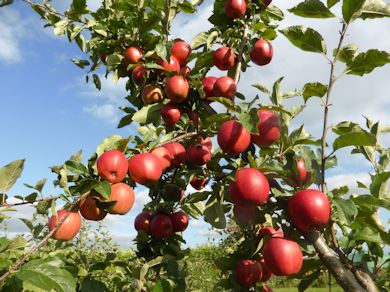
The success of this Pip to Plate event depended on the generosity of the representatives of the industry experts who gave up a day and in some cases traveled a considerable distance to be part of what may become an annual event tailored to inspire secondary school children to consider the fruit industry as a career option when they leave school and go onto higher education.
Feli Fernandez - represented East Malling Research
William Seabrook - represented W. Seabrook & Sons Ltd
John Clark and Philippe Parageaurd - represented FAST Ltd.
Mike Hutchinson - represented Hutchinsons
Simon Fitch and David Clough - represented ICA /STS
Simon Cannel and Lorna Clarke - represented Chingford Fruit Packers
Claire Donovan - represented Worldwide Fruit Ltd.
That is all for this week.......... next week an update on the progress of this seasons top fruit harvest.................
Take care
The English Apple Man